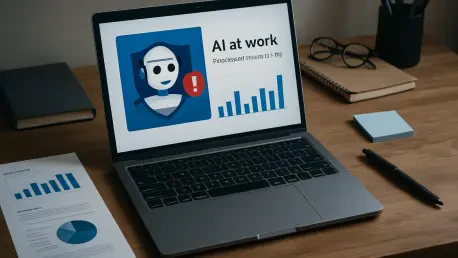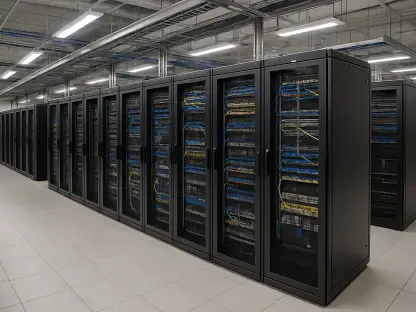Artificial Intelligence (AI) is reshaping the landscape of modern workplaces with unparalleled speed, offering tantalizing promises of enhanced productivity and groundbreaking innovation. Yet, beneath this wave of progress lies a troubling reality uncovered by a recent 1Password survey of 200 security leaders across North America. The findings paint a stark picture: the rapid integration of AI tools often races ahead of the security protocols meant to govern them, leaving organizations vulnerable to significant threats. From data breaches to compliance failures, the risks are mounting as employees embrace AI—often without oversight or awareness of the dangers. This article explores the critical challenges highlighted by the study, shedding light on the hidden vulnerabilities in today’s digital work environments and offering insights into potential solutions.
Unveiling the Security Challenges of AI Adoption
Limited Visibility into AI Usage
The lack of oversight over AI tools in workplaces stands out as a glaring issue, with the study revealing that a mere 21% of companies possess full visibility into the AI platforms their employees utilize. This blind spot has given rise to what experts call “Shadow AI,” where staff turn to public tools like ChatGPT without organizational approval or knowledge. Such unchecked usage mirrors historical patterns of rogue technology adoption—think early email or cloud storage—but the implications with AI are far graver. The potential for sensitive data exposure looms large, as these tools often operate outside the purview of corporate security measures. Without a clear understanding of who is using what, companies are left grappling with an invisible threat that could compromise their most valuable assets.
Beyond the numbers, the challenge of limited visibility underscores a deeper systemic problem in how technology adoption outpaces control mechanisms. Employees often adopt AI tools out of a genuine desire to boost efficiency, unaware of the risks they introduce. This isn’t just a matter of policy gaps; it’s a cultural issue where the allure of innovation overshadows caution. The study suggests that historical parallels, while instructive, don’t fully capture the scale of today’s AI-driven risks. Data processed by these tools can be far more sensitive than in past tech waves, amplifying the need for immediate action. Addressing this requires not just technological solutions but a fundamental shift in how organizations monitor and manage emerging tools in real time to prevent unseen vulnerabilities from spiraling into crises.
Weak Governance and Enforcement Gaps
A significant disconnect between creating AI policies and enforcing them emerges as another critical concern, with 54% of security leaders admitting that their governance efforts fall short. Even when rules exist, they often remain theoretical, lacking the teeth needed to ensure compliance. The study indicates that a substantial portion of employees—up to half in some estimates—use unauthorized AI tools, bypassing established guidelines. This gap exposes organizations to a host of dangers, including data breaches and violations of regulations like GDPR or HIPAA. It’s a clear signal that having a policy on paper isn’t enough; without active oversight and consistent application, these guidelines are rendered ineffective, leaving companies open to preventable risks.
This enforcement challenge isn’t merely about stricter rules but highlights a broader failure to adapt governance to the fast-evolving nature of AI technology. Many organizations struggle with outdated frameworks that can’t keep pace with the dynamic ways AI tools are accessed and used. The result is a workforce that, often unintentionally, circumvents policies due to inadequate monitoring or unclear communication of expectations. Bridging this gap demands more than just punitive measures; it calls for a proactive approach that integrates real-time tracking and fosters a culture of accountability. Only through such measures can companies transform well-intentioned policies into robust defenses against the security threats posed by unmanaged AI adoption.
Critical Risks Posed by Unmanaged AI Tools
Sensitive Data Exposure as a Major Threat
One of the most pressing risks identified by the study is the unintended sharing of sensitive information with AI tools, with 63% of security leaders pointing to this as a top internal threat. Employees, in their pursuit of efficiency, may input confidential data—such as customer details or proprietary code—into public AI platforms, oblivious to the potential consequences. These platforms can use such data to train large language models, risking exposure to external parties. This issue isn’t typically driven by malice but by a lack of awareness about how AI systems handle information. The danger lies in turning well-meaning staff into unwitting security liabilities, highlighting a critical need for education to mitigate this pervasive threat.
Compounding this risk is the subtle nature of data exposure, which often goes undetected until significant damage occurs. Unlike overt cyber threats, these incidents stem from routine workflows where AI tools are seen as harmless productivity aids. The study emphasizes that the scale of this problem is magnified by the sheer volume of data processed daily in modern workplaces. A single lapse can have cascading effects, undermining trust and triggering regulatory penalties. Addressing this requires more than just technical barriers; it necessitates a comprehensive approach to employee training that clarifies the boundaries of safe AI use. By equipping staff with the knowledge to recognize and avoid risky practices, organizations can transform a vulnerability into a strengthened line of defense.
Prevalence of Unmanaged AI Tools
The widespread use of unmanaged AI tools represents another formidable challenge, with over half of security leaders reporting that 26% to 50% of the AI tools in their organizations fall outside controlled environments. Unlike human users, AI tools can operate autonomously, often inheriting permissions that go unmonitored. This creates hidden pathways for data leaks and compliance issues, as legacy identity and access management systems are ill-equipped to handle AI’s dynamic nature. The study underscores that these unmanaged tools form blind spots where unauthorized access or data exfiltration can occur without detection, posing a significant threat to organizational security.
Further complicating the issue is the mismatch between traditional security frameworks and the unique behaviors of AI systems. Many existing systems were designed for static, human-centric access patterns, not the fluid, automated interactions of AI tools. This discrepancy allows for untracked data flows that can bypass standard controls, increasing the risk of breaches. Tackling this challenge demands a rethinking of access management, with tailored solutions that account for AI’s autonomous capabilities. The findings suggest that without updated protocols, organizations remain exposed to risks that could undermine their operational integrity. Modernizing these systems is not just a technical necessity but a strategic imperative to keep pace with AI’s rapid integration into daily workflows.
Trends and Solutions for AI Security
Accelerated Adoption vs. Lagging Security
A broader trend illuminated by the study is the stark contrast between the accelerated adoption of AI tools and the lagging security measures meant to govern them. Security leaders universally acknowledge the transformative potential of AI for productivity, yet they also recognize that its uncontrolled spread introduces unprecedented risks. This pattern of rapid tech uptake outstripping safeguards isn’t new—past waves of “shadow” technology adoption offer similar lessons—but AI’s data-intensive nature raises the stakes considerably. The consensus points to a pressing need for balanced approaches that embrace innovation while prioritizing robust security to prevent the benefits of AI from being overshadowed by preventable dangers.
This trend also reflects a deeper tension within organizations striving to remain competitive in a tech-driven landscape. The rush to implement AI often bypasses the slower, more deliberate process of establishing protective frameworks, creating a dangerous gap. The study highlights that employee behavior, frequently driven by unawareness rather than intent, plays a central role in amplifying these risks. Addressing this disparity requires a shift from reactive measures to proactive strategies that anticipate challenges before they escalate. By aligning security efforts with the pace of AI adoption, companies can harness its potential without sacrificing the integrity of their operations or data.
Strategies for Mitigating AI Risks
Looking back, the insights from the 1Password survey provide a sobering reminder of the vulnerabilities that accompany AI’s rise in workplaces. To counter these challenges, several actionable strategies emerged as vital steps forward. Documenting AI usage within workflows stands out as a foundational move, ensuring that organizations gain clarity on how and where these tools are deployed. Implementing governance and device trust solutions also proves essential, offering mechanisms to monitor and curb unauthorized AI access effectively. Collaboration across departments, such as with legal teams, further enriches understanding of AI adoption, aligning security with broader organizational goals.
Reflecting on past efforts, another key focus was employee training, which played a pivotal role in transforming potential risks into strengths. Equipping staff with the knowledge to use AI responsibly helped mitigate accidental data exposure significantly. Updating access control mechanisms also became a priority, with clear rules for AI tool connectivity and meticulous tracking of access for compliance purposes. In some cases, enforcing restrictions on public AI tools in sensitive settings was deemed necessary. These combined efforts underscore a path toward integrating effective AI governance into adoption strategies, ensuring that security evolves alongside innovation to safeguard workplaces against emerging threats.









